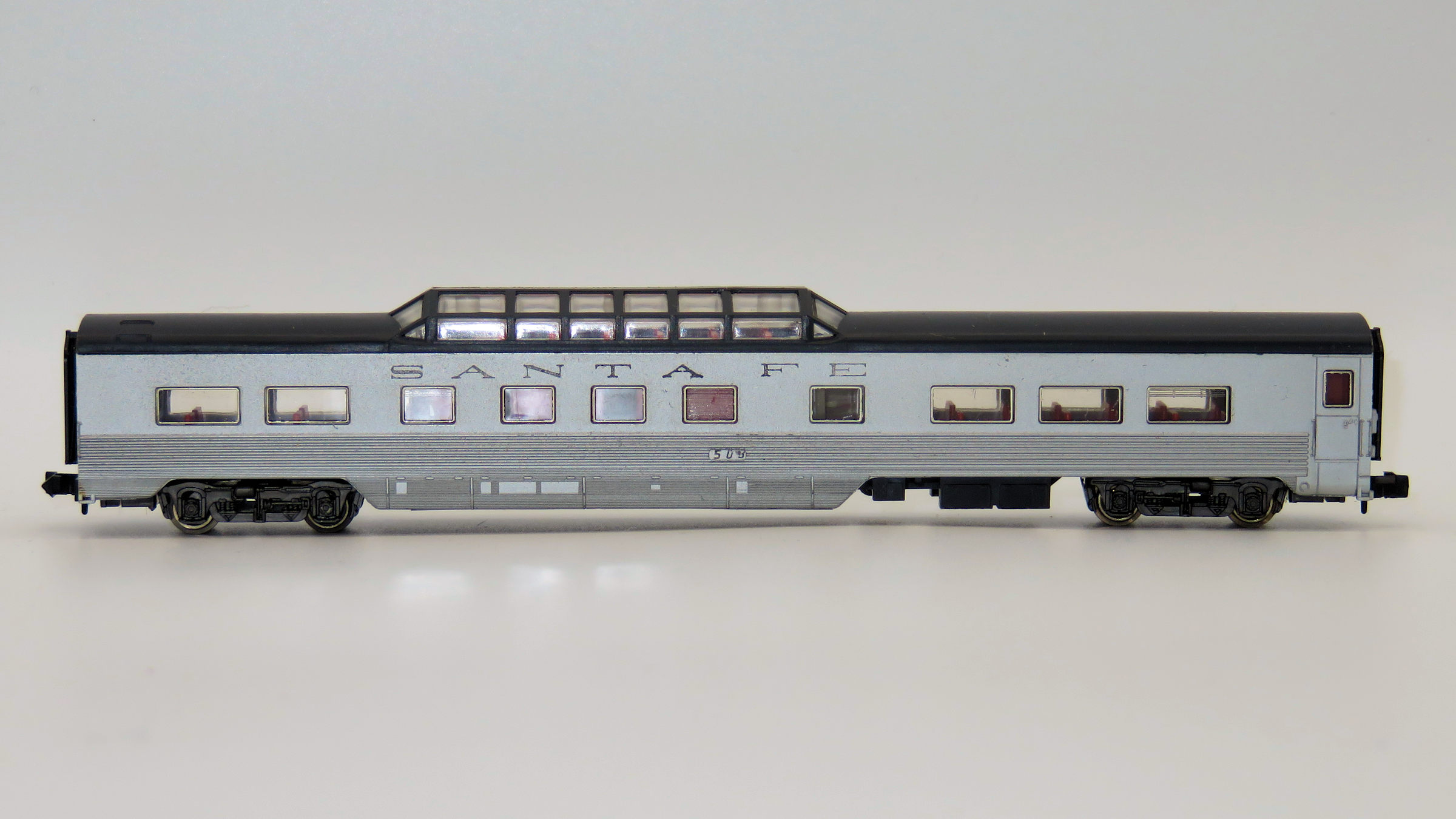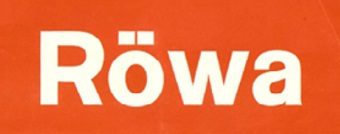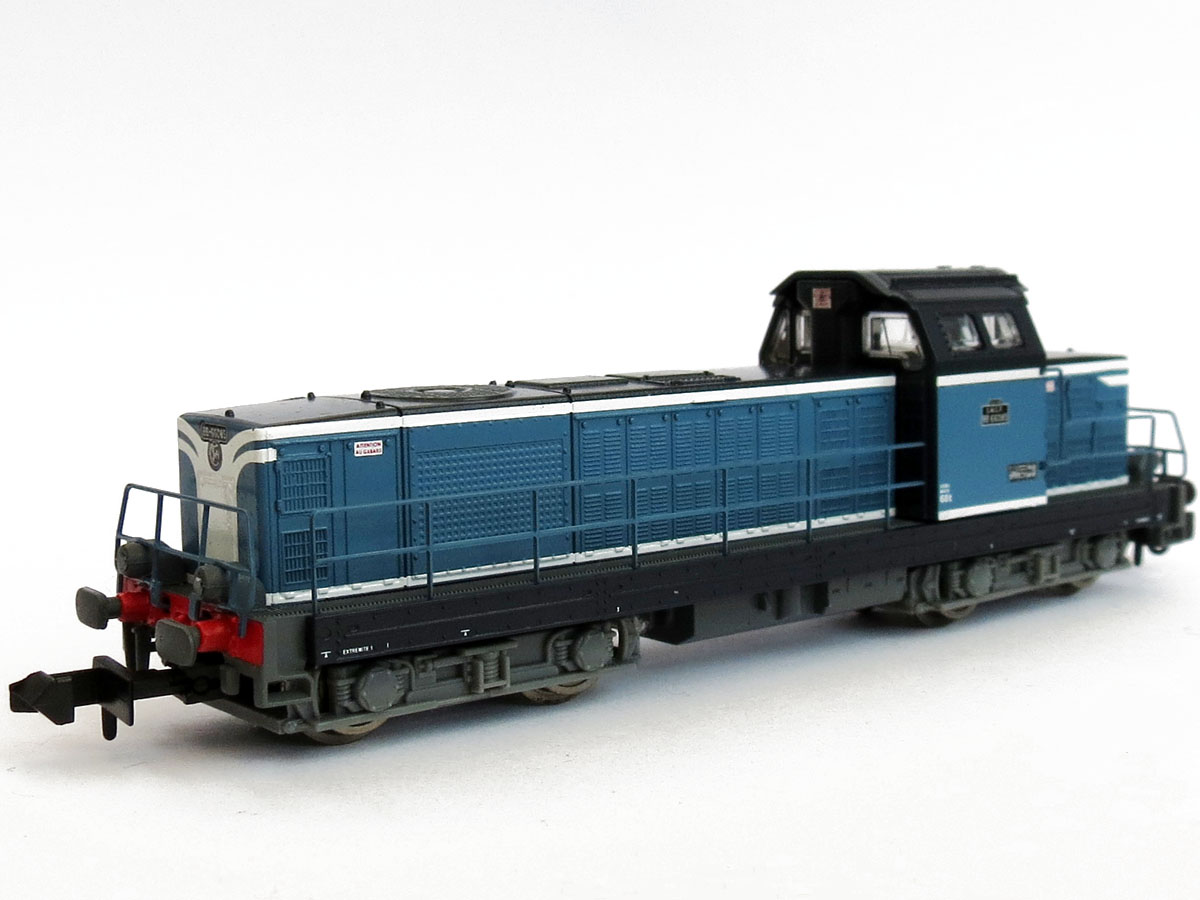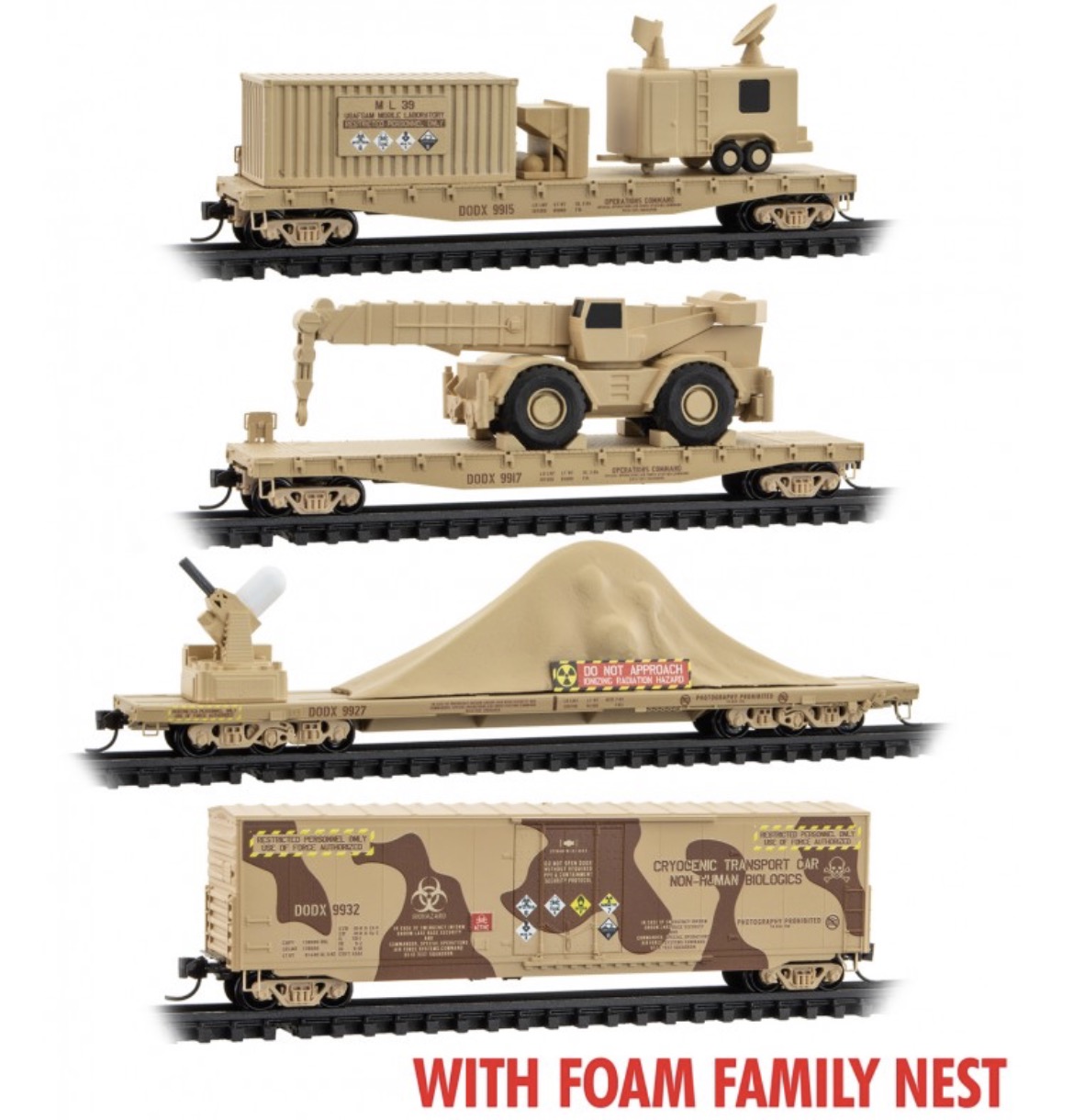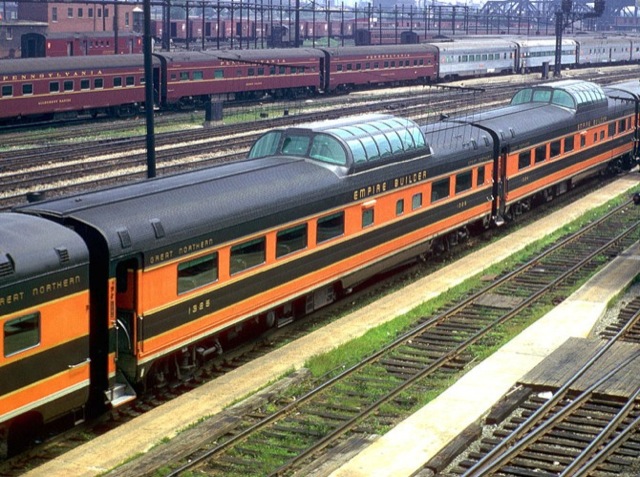Model Information: These cars were originally manufactured for MRC by Röwa (Germany) in the end 1960s-early 1970s. Röwa also sold them under its own brand. Post-MRC, Con-Cor distributed them for a while under its brand name and attempted to acquire the tooling in order to set up production of these cars at Rivarossi. However, said tooling was eventually lost (or confiscated) and these models subsequently vanished from the face of the earth. They have metal window frames, close-coupling, diaphragms and venetian blinds in the windows. Some come equipped with interior lighting.
This model was made after the Pullman Dome, but not matching a particular prototype. The lower corrugated part was similar to the ATSF Pleasure domes, but the dome itself is similar to the B&O Colombian dome; the sides' windows arrangement could have been inspired from Wabash and Texas & Pacific domes.
See here for more details.
This model was made after the Pullman Dome, but not matching a particular prototype. The lower corrugated part was similar to the ATSF Pleasure domes, but the dome itself is similar to the B&O Colombian dome; the sides' windows arrangement could have been inspired from Wabash and Texas & Pacific domes.
See here for more details.
Prototype History: The Vista-Dome is a deluxe coach with a glass compartment rising out of the roof. This railroad passenger car has a second floor with 24 or 30 seats, lots of windows and no obstructions. The front and rear walls of the dome are windows. The entire side of the dome is made of windows. Curved glass is used to transition from the side to the roofing on vista-domes. All of this glass allows passengers to view the all the great and vast scenery. At night only the only lights used are to illuminate the floor allowing passengers to look up and watch for falling stars. A Vista-Dome has only one set of stairs up and down. It is not the place to hide from a ticket collecting conductor.
The Chicago Burlington & Quincy Railroad, the Burlington Railroad, introduced the Vista-Dome passenger car into regular service in 1947 on it's Twin Zephyr train. It was part of the standard equipment of the California Zephyr train when that train started running on March 20, 1949. The Twin Cities Zephyr train included 5 Vista-Dome cars. Standard height dome cars, 24 inches over the roofline were not suitable for service on most eastern railroads because of clearance problems. Budd built domes with a 19 1/2 inch dome top for eastern service. The Baltimore and Ohio Railroad was the only pre-Amtrak east coast railroad that had Vista-Domes in revenue service. The domes were a part of the Columbian and Capitol trains.
More photos on this website.
The Chicago Burlington & Quincy Railroad, the Burlington Railroad, introduced the Vista-Dome passenger car into regular service in 1947 on it's Twin Zephyr train. It was part of the standard equipment of the California Zephyr train when that train started running on March 20, 1949. The Twin Cities Zephyr train included 5 Vista-Dome cars. Standard height dome cars, 24 inches over the roofline were not suitable for service on most eastern railroads because of clearance problems. Budd built domes with a 19 1/2 inch dome top for eastern service. The Baltimore and Ohio Railroad was the only pre-Amtrak east coast railroad that had Vista-Domes in revenue service. The domes were a part of the Columbian and Capitol trains.
More photos on this website.
Road Name History: 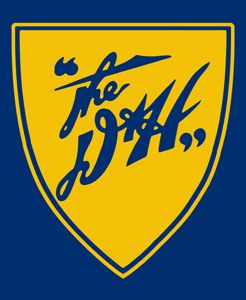 The Delaware and Hudson Canal Company would found the Delaware and Hudson Railway to support its mission of getting fuel to the timber denuded cities of the northeast when it was discovered that 'rock coal' or Anthracite could be burned successfully. In time the railway eclipsed the parent company, and America's brief canal age would be ended by the availability of more powerful traction locomotives, so today the canal is little known. Today the Delaware and Hudson Railway (reporting mark DH) is again a subsidiary railroad that operates in the northeastern United States. Since 1991 it was owned and operated by the Canadian Pacific Railway under the rail subsidiary Soo Line Corporation also controls the Soo Line Railroad, Canadian Pacific Railway is owned by Canadian Pacific Railway Limited.
The Delaware and Hudson Canal Company would found the Delaware and Hudson Railway to support its mission of getting fuel to the timber denuded cities of the northeast when it was discovered that 'rock coal' or Anthracite could be burned successfully. In time the railway eclipsed the parent company, and America's brief canal age would be ended by the availability of more powerful traction locomotives, so today the canal is little known. Today the Delaware and Hudson Railway (reporting mark DH) is again a subsidiary railroad that operates in the northeastern United States. Since 1991 it was owned and operated by the Canadian Pacific Railway under the rail subsidiary Soo Line Corporation also controls the Soo Line Railroad, Canadian Pacific Railway is owned by Canadian Pacific Railway Limited.
The name itself originates from the 1823 New York state corporation charter listing the unusual name of "The President, Managers and Company of the Delaware & Hudson Canal Co." authorizing an establishment of "water communication" between the Delaware River and the Hudson River.
Nicknamed "The Bridge Line to New England and Canada," the D&H helped connect New York with Montreal, Quebec and New England. It called itself "North America's oldest continually operated transportation company." Between 1968 & 1984, the D&H was owned by Norfolk & Western. N&W sold it to Guilford Transportation, who cast it into bankruptcy in 1988 and in 1991, the D&H was purchased by Canadian Pacific Railway (CP).
On September 19, 2015, Norfolk Southern Railway assumed control and began operations of their recently acquired Delaware & Hudson "South Line", the 282 miles from Schenectady, New York to Sunbury, Pennsylvania from CP. The Delaware & Hudson "South Line" is a rail route that now consists of three rail lines, the Sunbury Line, the Freight Line, and the Voorhesville Running Track; the Sunbury Line absorbed the original route of the Delaware, Lackawanna and Western Railroad main line which contains the Nicholson Cutoff during that rail line's history.

The name itself originates from the 1823 New York state corporation charter listing the unusual name of "The President, Managers and Company of the Delaware & Hudson Canal Co." authorizing an establishment of "water communication" between the Delaware River and the Hudson River.
Nicknamed "The Bridge Line to New England and Canada," the D&H helped connect New York with Montreal, Quebec and New England. It called itself "North America's oldest continually operated transportation company." Between 1968 & 1984, the D&H was owned by Norfolk & Western. N&W sold it to Guilford Transportation, who cast it into bankruptcy in 1988 and in 1991, the D&H was purchased by Canadian Pacific Railway (CP).
On September 19, 2015, Norfolk Southern Railway assumed control and began operations of their recently acquired Delaware & Hudson "South Line", the 282 miles from Schenectady, New York to Sunbury, Pennsylvania from CP. The Delaware & Hudson "South Line" is a rail route that now consists of three rail lines, the Sunbury Line, the Freight Line, and the Voorhesville Running Track; the Sunbury Line absorbed the original route of the Delaware, Lackawanna and Western Railroad main line which contains the Nicholson Cutoff during that rail line's history.
Brand/Importer Information: Con-Cor has been in business since 1962. Many things have changed over time as originally they were a complete manufacturing operation in the USA and at one time had upwards of 45 employees. They not only designed the models,but they also built their own molds, did injection molding, painting, printing and packaging on their models.
Currently, most of their manufacturing has been moved overseas and now they import 90% of their products as totally finished goods, or in finished components. They only do some incidental manufacturing today within the USA.
Important Note: The Con-Cor product numbering can be very confusing. Please see here in the article how to properly enter Con-Cor stock numbers in the TroveStar database.
Currently, most of their manufacturing has been moved overseas and now they import 90% of their products as totally finished goods, or in finished components. They only do some incidental manufacturing today within the USA.
Important Note: The Con-Cor product numbering can be very confusing. Please see here in the article how to properly enter Con-Cor stock numbers in the TroveStar database.
Manufacturer Information: Röwa was founded in 1961 by Willy Ade and Horst Röchling, the company name being an acronym of their combined names. For several years, much of Röwa’s energies were directed toward developing products for other model train manufacturers, notably Trix of Germany and, on occasion, Roco of Austria.
Production of model trains under the Röwa name began in the late 1960’s, ca. 1968. Much of the company’s products were in H0-Scale, but there was some interesting production in N-Scale.
The Röwa American-prototype N-Scale items were marketed in the United States by Model Rectifier Corporation (MRC) for a period of a few years. Both the locomotives and passenger cars were subsequently marketed by other companies in successive years. For example, Brawa and Con-Cor marketed the N&W Y-6b Mallet-type, and the Berkshire may have also been marketed in the same way. Con-Cor owned the passenger car tooling for a period of time, producing until the die-molds went out of production tolerances.
Röwa ended production around 1974 and the manufacturing tools and dies used to produce the trains were sold to other companies.
From this website.
Production of model trains under the Röwa name began in the late 1960’s, ca. 1968. Much of the company’s products were in H0-Scale, but there was some interesting production in N-Scale.
The Röwa American-prototype N-Scale items were marketed in the United States by Model Rectifier Corporation (MRC) for a period of a few years. Both the locomotives and passenger cars were subsequently marketed by other companies in successive years. For example, Brawa and Con-Cor marketed the N&W Y-6b Mallet-type, and the Berkshire may have also been marketed in the same way. Con-Cor owned the passenger car tooling for a period of time, producing until the die-molds went out of production tolerances.
Röwa ended production around 1974 and the manufacturing tools and dies used to produce the trains were sold to other companies.
From this website.
Item created by: gdm on 2017-03-06 10:04:39. Last edited by Alain LM on 2020-11-02 01:57:35
If you see errors or missing data in this entry, please feel free to log in and edit it. Anyone with a Gmail account can log in instantly.
If you see errors or missing data in this entry, please feel free to log in and edit it. Anyone with a Gmail account can log in instantly.


